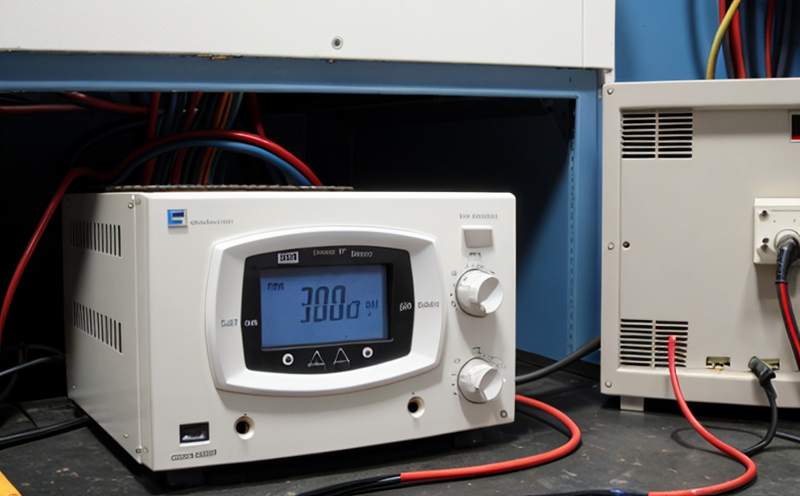IEC 61000 3 2 Harmonic Current Emission Testing of Lighting Devices
The IEC 61000 series of standards is a comprehensive suite designed to address electromagnetic compatibility (EMC) and the performance of electrical/electronic equipment in power systems. Specifically, IEC 61000-3-2 focuses on harmonic current emissions from non-linear loads, which are critical considerations for modern lighting devices due to their reliance on solid-state electronics.
Harmonic currents can cause significant issues within electrical distribution networks. These include increased losses in power transformers and conductors, voltage distortion, and potential interference with communication systems and other sensitive electronic equipment. This is particularly relevant for LED lighting, which has a high power factor but emits harmonic currents that need to be tested to ensure compliance.
The testing outlined by IEC 61000-3-2 involves measuring the harmonic currents generated by lighting devices under specified conditions. The test setup includes an artificial load that simulates the operation of the device, and the measurement is conducted over a broad frequency range from 5 Hz to 400 kHz.
For LED lights, this testing ensures that they comply with international standards regarding harmonic current emissions. Compliance helps prevent interference in power quality, improves system reliability, and supports environmental sustainability by reducing energy losses and potential damage to other equipment.
The process begins with the preparation of the specimen according to IEC guidelines. This includes ensuring the lighting device is representative of real-world conditions and that all relevant parameters are set correctly before testing. The test setup typically consists of a power supply, an artificial load, measurement instruments, and a harmonic current analyzer.
During the test, the specimen is powered under specific loading conditions to simulate actual usage scenarios. The output currents are then measured at various points in the frequency spectrum. Compliance with IEC 61000-3-2 requires that the total harmonic distortion (THD) of the current does not exceed specified limits for different types and classes of lighting devices.
The importance of this testing cannot be overstated, especially given the increasing adoption of LED technology in residential, commercial, and industrial settings. By ensuring compliance with these standards, manufacturers can guarantee that their products will perform reliably without causing power quality issues or environmental harm. This is particularly crucial for energy-efficient lighting solutions aimed at reducing overall electricity consumption.
Compliance also opens doors to international markets where stringent regulations on harmonic emissions exist. For instance, countries like the United States and Europe have specific requirements under IEEE and IEC standards that must be met by imported products. Meeting these standards not only facilitates market access but also enhances brand reputation among consumers who are increasingly aware of sustainability issues.
In summary, IEC 61000-3-2 testing is essential for manufacturers aiming to produce high-quality LED lighting devices. It ensures that the harmonic emissions from these devices meet stringent international standards, thereby supporting both technical performance and environmental responsibility.
Benefits
Compliance with IEC 61000-3-2 offers numerous benefits to manufacturers and users of lighting devices. For manufacturers, it ensures that their products are reliable, efficient, and environmentally friendly, meeting international standards for quality and performance.
- Market Access: Compliance opens doors to international markets with stringent regulations on harmonic emissions.
- Increased Reliability: By ensuring compliance during the manufacturing process, potential issues are identified early, leading to more reliable products.
- Sustainability: Reduced harmonic distortion leads to lower energy losses and less environmental impact.
- Better Performance: Ensuring that devices meet IEC standards can improve overall product performance, enhancing user satisfaction.
For users of lighting devices, compliance translates into better-performing products. Reliable lighting systems enhance the quality of life by providing consistent and efficient light output while minimizing disruptions caused by power quality issues.
Moreover, manufacturers that comply with these standards benefit from a positive brand image, which can attract environmentally conscious consumers who are increasingly prioritizing sustainability in their purchasing decisions.
Environmental and Sustainability Contributions
- Energy Efficiency: By reducing harmonic currents, the system's overall energy efficiency is improved, leading to lower electricity consumption and reduced carbon footprint.
- Resource Conservation: Lower energy losses mean that less raw material is required for production, contributing to resource conservation efforts.
- Emissions Reduction: Reduced power quality issues result in fewer emissions from power plants, supporting global climate goals.
- Biodiversity Preservation: By reducing the environmental impact of lighting systems, there's a positive effect on local ecosystems and biodiversity.
The overall goal is to ensure that the production, use, and disposal phases of these lighting devices have minimal adverse effects on the environment. This aligns with broader sustainability goals set by global organizations like the United Nations Environment Programme (UNEP).
Competitive Advantage and Market Impact
Compliance with IEC 61000-3-2 provides significant competitive advantages for manufacturers of lighting devices. In a highly regulated market, compliance is often a prerequisite for entry into specific regions or industries.
Manufacturers that meet these standards can position their products as environmentally friendly and technologically advanced, appealing to consumers who are increasingly concerned about sustainability. This can lead to increased market share and customer loyalty.
Furthermore, compliance with international standards enhances the reputation of manufacturers among industry peers and regulatory bodies, which can translate into better business relationships and opportunities for collaboration.
The impact on the market is also notable. Compliance ensures that products meet high-quality benchmarks, which can lead to improved product reliability and performance. This, in turn, can drive innovation within the industry as companies strive to exceed these standards.
Overall, compliance with IEC 61000-3-2 not only enhances a manufacturer's competitive position but also contributes positively to the broader market by promoting high-quality, sustainable products.





